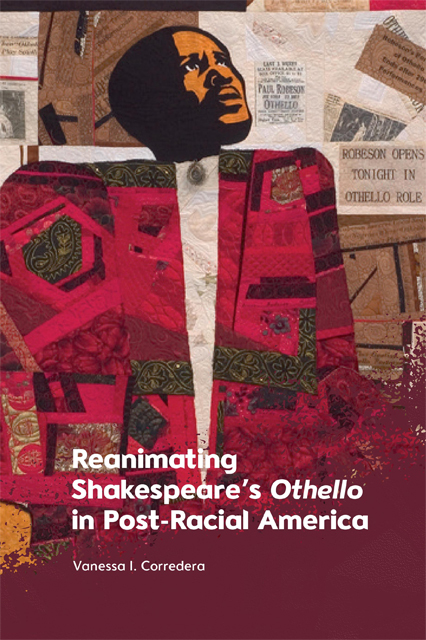Book contents
- Frontmatter
- Contents
- Acknowledgments
- Permissions
- Introduction
- 1 Images of Objectification: Othello as Prop in Kill Shakespeare
- 2 Colorblindness on the Post-Racial Stage: Hip Hop, Comedy, and Cultural Appropriation in Othello: The Remix
- 3 Othello, Race, and Serial: The Ethics of a Shakespearean Cameo
- 4 “No tools with which to hear”: Adaptive Re-Vision, Audience Education, and American Moor
- 5 At the Intersection of Gender, Race, and White Privilege: A Case of Three Desdemona Plays
- 6 Resisting Lobotomized Shakespeare: Whiteness and Universality in Key & Peele and Get Out
- Epilogue
- Bibliography
- Index
1 - Images of Objectification: Othello as Prop in Kill Shakespeare
Published online by Cambridge University Press: 25 October 2023
- Frontmatter
- Contents
- Acknowledgments
- Permissions
- Introduction
- 1 Images of Objectification: Othello as Prop in Kill Shakespeare
- 2 Colorblindness on the Post-Racial Stage: Hip Hop, Comedy, and Cultural Appropriation in Othello: The Remix
- 3 Othello, Race, and Serial: The Ethics of a Shakespearean Cameo
- 4 “No tools with which to hear”: Adaptive Re-Vision, Audience Education, and American Moor
- 5 At the Intersection of Gender, Race, and White Privilege: A Case of Three Desdemona Plays
- 6 Resisting Lobotomized Shakespeare: Whiteness and Universality in Key & Peele and Get Out
- Epilogue
- Bibliography
- Index
Summary
Depicting Othello: Visual and Ideological Distortions
What does Othello look like? Here, I mean not the character, nor the play, but rather the material text of Othello itself, specifically the cover images of popular editions. When one pauses to examine these images, which function as first impressions of the play, one finds that, disturbingly, many of them contain long-circulating antiblack conceptualizations about both Othello and Black masculinity more broadly. The Oxford Othello, for instance, displays the 1826 James Northcote portrait of Ira Aldridge entitled A Moor. While the title evokes the play’s performance history—Aldridge was the first Black actor to perform Othello in England—it also operationalizes the racist, colonizing move of eschewing singularity in favor of grouping people into “an anonymous collectivity,” what Albert Memmi calls “the mark of the plural” (129). The portrait’s title, A Moor, conflates Aldridge with the role, creating an overlap that instantiates the collapsing of individuality into racial collectivity so commonly enacted by and articulated through white supremacist structures and ideologies. In other words, the vague title not only applies an anachronistic appellation to Aldridge but does so in a way suggesting that the distinction between the actor and the part he performed is of no consequence. Indeed, Aldridge was not identified as the portrait’s subject until 1983 (British Library). This is the same ideological turn to group identity underpinning Iago’s assertion that “These Moors are changeable in their wills” (I, iii, 339): apparently, the portrait suggests, also in their names, their very identities. The Aldridge image thus indicates how problems related to race and representation remain ever present in Othello before a page has even been turned.
The Norton Critical Edition shifts from an antiblack ideological construction to the reification of an antiblack stereotype applied to Othello as it too looks to the stage for its imagery. It depicts Adrian Lester as Othello, dressed in tan military fatigues against a tan wall, peeking out from behind it or perhaps a curtain. The indeterminacy of this object matters, for it suggests a thematic emphasis before the reader opens the text. Initially, it seems as if one is seeing Lester’s image reflected on a translucent white wall or perhaps showing through a transparent curtain.
- Type
- Chapter
- Information
- Reanimating Shakespeare's Othello in Post-Racial America , pp. 29 - 76Publisher: Edinburgh University PressPrint publication year: 2022



